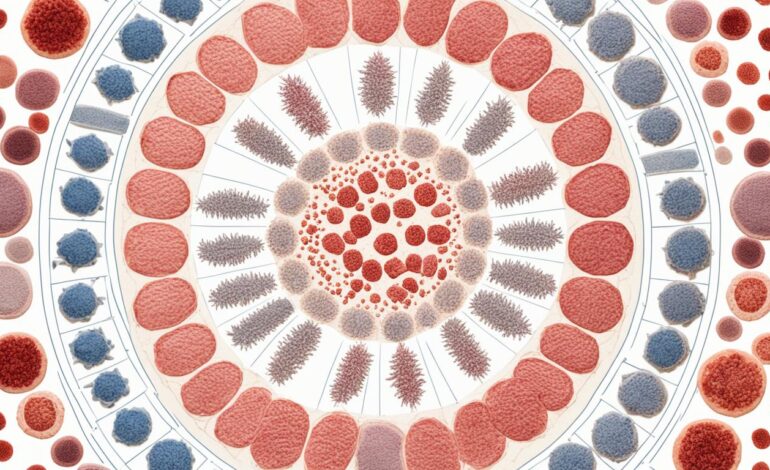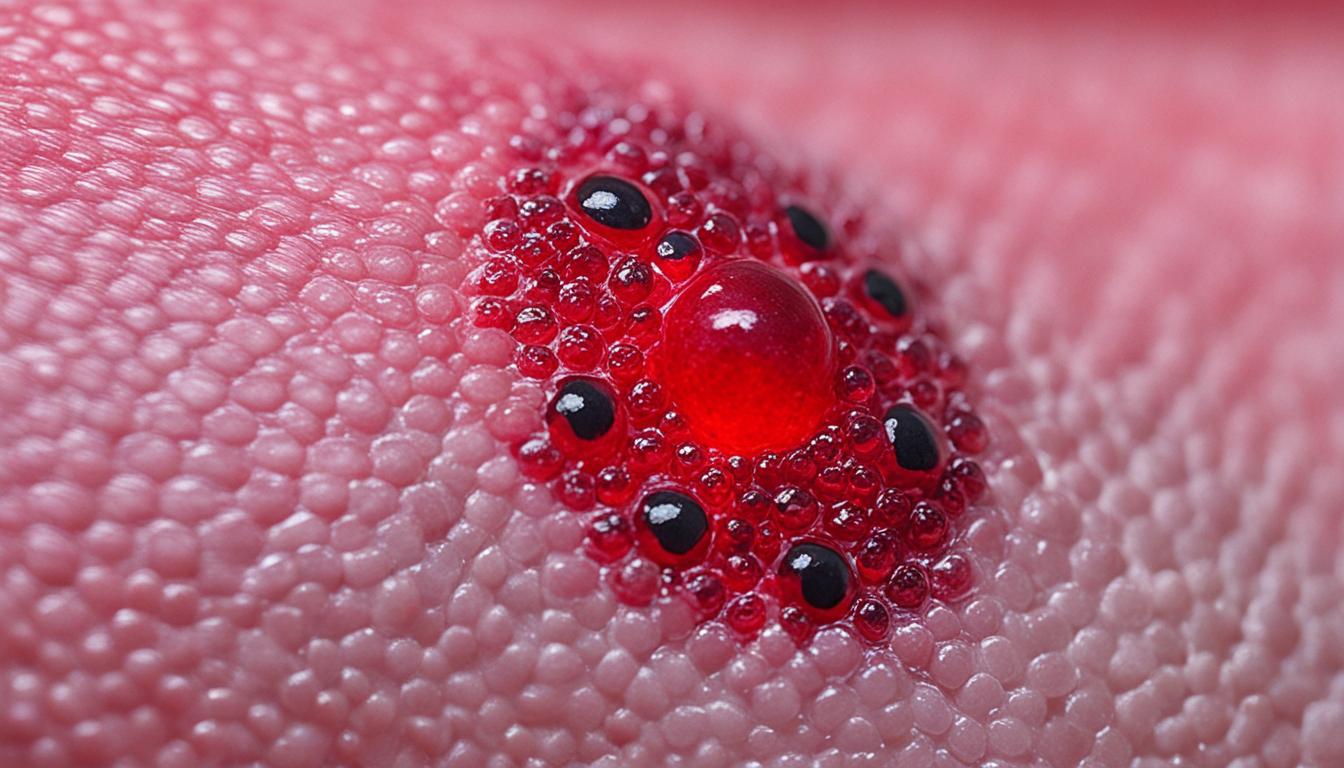What Are The Types Of Skin Infections?

Skin infections can come from many sources like bacteria, viruses, fungi, and parasites. They can be mild or severe and are usually treatable. But, if not treated, some can get worse, spreading deeper or across the body.
People with weak immune systems, like those with chronic illnesses or on certain treatments, are more likely to get skin infections. These infections can lead to more serious problems. Mild infections might be treated with over-the-counter drugs or home remedies. But, serious cases often need a doctor’s care and prescription treatments.
Key Takeaways
- Skin infections can be caused by bacteria, viruses, fungi, and parasites.
- Infections can range from mild to severe, and most are highly treatable.
- Individuals with weakened immune systems have a higher risk of skin infections and complications.
- Over-the-counter medications and home remedies can often treat mild infections, but more serious cases may require medical attention.
- Proper diagnosis and treatment are important to prevent the infection from worsening or spreading.
Introduction to Skin Infections
Skin infections are a common health issue caused by bacteria, viruses, fungi, and parasites. They happen when these microorganisms get into the skin through cuts, scratches, or injuries. Knowing the causes and risk factors of skin infections helps in preventing and treating them.
Also Read : What Ingredients Should You Avoid To Prevent Skin Irritation?
Causes and Risk Factors
Many things can lead to skin infections, like weakened immune systems, poor hygiene, skin folds, and exposure to certain pathogens. People with chronic illnesses like diabetes or HIV/AIDS are more likely to get skin infections. Not washing hands well or not taking good care of your skin also raises the risk of skin rashes and infections.
Also Read : What Are The Best Ways To Prevent Skin Allergies?
Jobs or activities that expose you to skin lesion infections can also increase your risk. For instance, healthcare workers or those who work with animals might get certain skin infections more easily.
Also Read : How Do Antioxidants Protect Skin from Damage?
Symptoms
Symptoms of skin infections vary by the type of pathogen and how severe the infection is. Common signs include redness, swelling, pain, itching, and the development of lesions or rashes. Some infections may also cause fever, chills, or other symptoms.
Also Read : How Can You Use Citrus Fruits In A Skincare Diet?
If you notice any of these symptoms, see a doctor right away. Quick diagnosis and treatment can stop the infection from getting worse or spreading.
Also Read : Lumens Skin Care for Men: Grooming Essentials
Bacterial Skin Infections

Bacterial skin infections are common and affect millions globally. They happen when bacteria get into the skin through cuts or hair follicles. Types include cellulitis, impetigo, boils, and Hansen’s disease, which is rare but serious.
Common Bacterial Infections
Cellulitis is a serious infection that makes the skin swell, turn red, and hurt. It can spread fast and cause serious issues if not treated. Impetigo is a contagious infection in kids that leads to blisters and sores.
Boils are painful bumps filled with pus. They happen when bacteria infect a hair follicle. These infections are often caused by Staphylococcus aureus, or staph infections.
Less common infections like syphilis, tuberculosis, and leptospirosis can also show on the skin. Syphilis starts with a sore that doesn’t hurt. Tuberculosis can cause skin lesions and discoloration.
Symptoms and Treatment
Symptoms of bacterial skin infections vary but often include redness, swelling, pain, and sores or blisters. Severe cases may bring fever, chills, and illness.
Most infections can be treated with antibiotics, either on the skin or by mouth. Sometimes, doctors need to cut and drain infected areas to help healing.
Seeing a doctor quickly for bacterial skin infections is key. Early treatment stops the infection from getting worse and prevents complications. Knowing about these infections and their signs helps keep skin healthy and ensures timely medical care.
Viral Skin Infections
Viruses can cause many contagious skin infections. These include viral skin infections, shingles, chickenpox, Molluscum contagiosum, warts, measles, and hand, foot, and mouth disease. These infections can show up as rashes, blisters, or wart-like spots on the skin.
Herpes simplex is a common viral infection that causes cold sores or fever blisters near the mouth. Herpes zoster, or shingles, is caused by the same virus as chickenpox. It leads to a painful rash along a nerve pathway.
These infections are very contagious and can spread through touch, droplets in the air, or touching surfaces that are contaminated. To stop the spread and manage symptoms, it’s key to practice good hygiene. Avoid being close to people who are infected and get medical help quickly if needed.
| Viral Skin Infection | Causative Virus | Symptoms |
|---|---|---|
| Shingles | Varicella-zoster virus | Painful rash with blisters along a nerve pathway |
| Chickenpox | Varicella-zoster virus | Itchy rash with red spots and fluid-filled blisters |
| Molluscum contagiosum | Molluscum contagiosum virus | Small, flesh-colored, dome-shaped bumps |
| Warts | Human papillomavirus (HPV) | Rough, raised growths on the skin |
| Measles | Measles virus | Red, itchy rash that starts on the face and spreads downward |
| Hand, foot, and mouth disease | Coxsackievirus | Painful blisters on the hands, feet, and mouth |
Dealing with viral skin infections can be tough. Some may need antiviral drugs or special treatments. Always talk to a doctor for the right diagnosis and treatment. This helps reduce the risk of serious problems and stops the spread of these infections.
“Viral skin infections can be highly contagious and may spread through direct contact, respiratory droplets, or contact with contaminated surfaces.”
Fungal Skin Infections

Fungal skin infections are quite common and can affect different parts of the body. They are caused by fungi that love moist, warm places. These spots include the feet, armpits, and skin folds. Knowing about these infections, their causes, and how to prevent them can keep your skin healthy and glowing.
Types of Fungal Infections
Here are some common fungal skin infections:
- Athlete’s foot: This infection hits the feet, especially between the toes.
- Yeast infections: Known as candidiasis, they can pop up on the skin, in the mouth (oral thrush), or in the vagina.
- Ringworm: This looks like a red circle on the skin, scalp, or nails and is caused by a fungus.
- Nail fungus: This makes the nails turn color and get thick.
- Diaper rash: A fungal infection that happens in the skin folds of babies and young kids.
These infections, or dermatophyte infections, are caused by fungi like Trichophyton, Candida, and Microsporum.
Risk Factors and Prevention
Some things can make you more likely to get fungal skin infections, such as:
- Wearing closed-toe shoes for a long time, making your feet sweaty.
- Moist areas like the armpits and groin.
- Having a weak immune system makes you more at risk.
To avoid these infections, keep your skin clean and dry. Wash and dry the affected areas well, wear breathable clothes, and don’t share towels or clothes. You can also use over-the-counter antifungal creams and powders to help prevent these infections.
Skin Infections

Parasitic Infections
Parasitic skin infections happen when small organisms burrow into the skin and lay eggs. These infections can move from the skin to the bloodstream and organs. Common ones include lice, bedbugs, and scabies. They cause itching, rashes, and other symptoms.
Diagnosis and Treatment
To diagnose these infections, doctors do a physical exam and lab tests, like a skin culture. Treatment might be antiparasitic drugs or home remedies for itching and swelling. If the infection keeps coming back, you might need more tests and treatment to find the cause.
- Parasitic skin infections can be caused by lice, bedbugs, scabies, and other small organisms
- These infections can spread beyond the skin and affect the bloodstream and organs
- Diagnosis often involves a physical exam and lab tests, such as a skin culture
- Treatment may include antiparasitic medications and home remedies to manage symptoms
- Chronic or recurring skin infections may require additional medical care
“Proper diagnosis and prompt treatment are essential for managing parasitic skin infections and preventing further complications.”
Good hygiene, avoiding close contact with infected people, and checking for parasites can prevent these infections. If you think you have one, see a doctor quickly. This helps stop the infection from getting worse or lasting a long time.
Also Read : What Are Effective Home Remedies For Fine Lines?
Conclusion
Skin infections can come from many sources like bacteria, viruses, fungi, and parasites. Knowing about the different types of skin infections is key. It helps us prevent and manage them well.
Whether it’s a simple bacterial infection or a complex fungal or parasitic issue, getting medical help quickly is vital. This helps avoid serious problems and ensures the right treatment.
Learning about skin infections, their risks, and how to treat them helps us take action. Regular skincare, good hygiene, and watching for any unusual changes are important steps. These actions help in managing and preventing skin infections.
Dealing with skin infections needs a full approach. It includes medical help, taking care of ourselves, and understanding these conditions well. By staying informed and getting medical help when needed, we protect our skin’s health. This keeps our skin looking healthy and vibrant.
FAQs
Q : What are the different types of skin infections?
Skin infections can come from many sources like bacteria, viruses, fungi, and parasites. They can lead to different infections, including cellulitis, impetigo, ringworm, athlete’s foot, shingles, and scabies.
Q : What are the causes and risk factors for skin infections?
Skin infections happen when pathogens get into the skin, often through cuts or scratches. People with weak immune systems, poor hygiene, skin folds, or exposure to certain pathogens are at higher risk. Symptoms include redness, swelling, pain, itching, and lesions.
Q : What are the common bacterial skin infections and how are they treated?
Bacterial skin infections come from bacteria entering the skin, often through hair follicles or wounds. Common ones include cellulitis, impetigo, boils, and Hansen’s disease. These infections are treated with antibiotics, either topical or oral, based on how severe they are.
Q : What are the main types of viral skin infections?
Viruses can cause contagious and systemic skin infections. Examples are shingles, chickenpox, Molluscum contagiosum, warts, measles, and hand, foot, and mouth disease. These viral infections show a variety of symptoms on the skin.
Q : What are the common fungal skin infections and how can they be prevented?
Fungal infections happen when fungi infect moist parts of the body, like the feet, armpits, and skin folds. Common ones are athlete’s foot, yeast infections, ringworm, and nail fungus. Keeping skin dry and practicing good hygiene can prevent these infections.
Q : What are the types of parasitic skin infections and how are they diagnosed and treated?
Parasitic skin infections are caused by small organisms that live in the skin and lay eggs, like lice, bedbugs, and scabies. These infections can spread to the bloodstream and organs. Doctors diagnose them with a physical exam and lab tests, such as skin cultures. Treatment includes antiparasitic medications and home remedies for symptoms.





